


Fall Protection Equipment Ensuring Safety in the Workplace
In various industries, particularly construction, maintenance, and manufacturing, fall hazards pose significant risks to workers. According to the Occupational Safety and Health Administration (OSHA), falls are one of the leading causes of serious work-related injuries and fatalities. To mitigate these risks, fall protection equipment is essential for ensuring the safety of employees working at heights. This article delves into the types of fall protection equipment, their importance, and best practices to maximize safety.
Types of Fall Protection Equipment
1. Personal Fall Arrest Systems (PFAS) PFAS are designed to safely stop a worker from falling after a fall has occurred. These systems typically consist of a harness, lanyard, and anchorage point. Harnesses must be properly fitted and regularly inspected to ensure their effectiveness.
2. Guardrails Guardrails are barriers erected along the edges of platforms, roofs, or stairways to prevent workers from falling. They should be constructed according to the applicable safety standards, which specify the required height, load capacity, and spacing of the rails.
3. Safety Nets Used in construction sites, safety nets are installed below the working area to catch falling workers and debris. They must be positioned as close to the work surface as possible and should be inspected regularly for any damage or wear.
4. Lifelines Lifelines are anchored lines that workers can attach to their harnesses. They allow workers to move freely while providing security against falls. There are two types of lifelines horizontal and vertical. Horizontal lifelines are anchored at both ends, while vertical lifelines are usually used for climbing.
5. Platforms and Scaffolding Temporary work platforms and scaffolding systems are common in construction. These systems must be stable and designed to safely support the weight of workers and materials.
Importance of Fall Protection Equipment
The implementation of fall protection equipment is vital for several reasons
- Worker Safety The primary purpose of fall protection is to safeguard workers from fall hazards
. By using appropriate equipment, employers can significantly reduce the risk of accidents and injuries.
- Compliance with Regulations OSHA mandates specific fall protection standards that employers must follow. Non-compliance can result in hefty fines and legal repercussions. Investing in fall protection equipment helps companies comply with these regulations.
- Enhancing Productivity When workers feel safe and secure, they are more likely to perform their tasks efficiently. A robust fall protection program can lead to fewer accidents, reduced downtime due to injuries, and enhanced productivity overall.
- Promoting a Safety Culture Providing workers with fall protection equipment demonstrates an employer's commitment to safety. It fosters a culture where safety is prioritized, encouraging workers to adhere to safety protocols.
Best Practices for Fall Protection
1. Assessment of Fall Hazards Employers should conduct thorough assessments to identify potential fall hazards in the workplace. Regular inspections can help pinpoint new risks and facilitate timely interventions.
2. Training and Education It is crucial that workers are trained in the proper use of fall protection equipment. This includes understanding how to wear harnesses correctly, using lifelines, and recognizing hazardous situations.
3. Regular Maintenance and Inspections Fall protection equipment must be regularly maintained and inspected to ensure its functionality and safety. Any damaged or worn-out equipment should be replaced immediately.
4. Developing an Emergency Response Plan In case of a fall incident, having an effective emergency response plan is essential. Workers should be trained on the procedures to follow during emergencies, including how to rescue a fallen co-worker safely.
Conclusion
Fall protection equipment is a critical component in safeguarding workers from the dangers associated with working at heights. By understanding the different types of equipment, their importance, and adhering to best practices, employers can create a safer work environment. Prioritizing fall protection not only protects workers but also fosters a culture of safety, enhancing productivity and compliance with regulations. In the end, investing in fall protection is investing in the well-being of employees and the overall success of a company.



